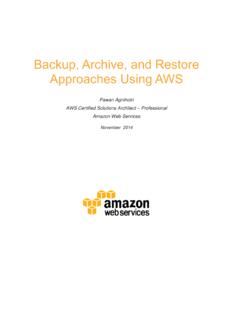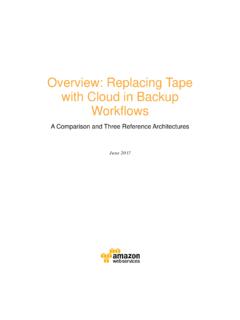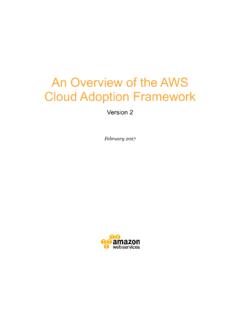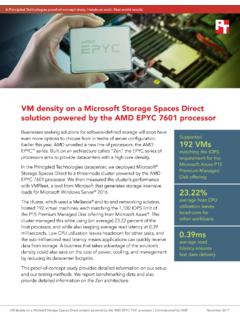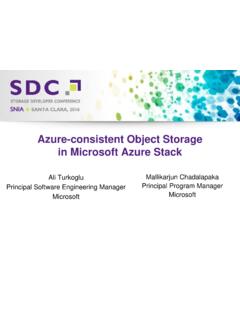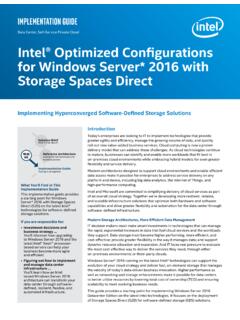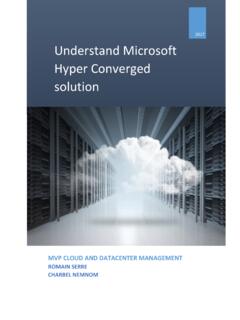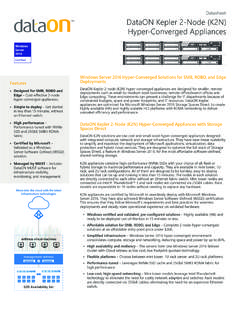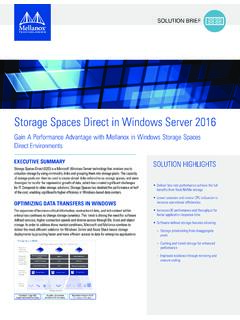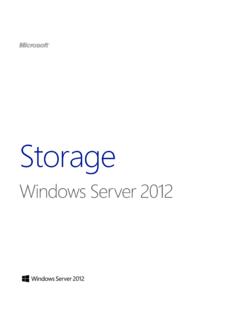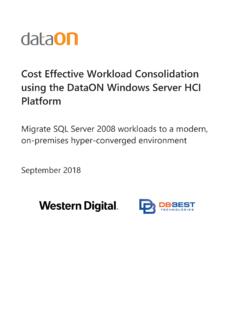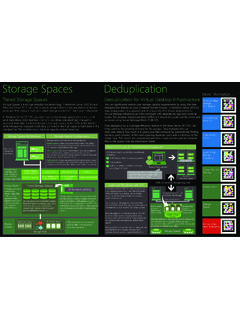Transcription of Using Windows Storage Spaces and iSCSI on Amazon EBS
1 Using Windows Storage Spaces and iSCSI on Amazon EBS October 2015 Amazon Web Services Using Windows Storage Spaces and iSCSI on Amazon EBS October 2015 Page 2 of 33 2015, Amazon Web Services, Inc. or its affiliates. All rights reserved. Notices This document is provided for informational purposes only. It represents AWS s current product offerings and practices as of the date of issue of this document, which are subject to change without notice. Customers are responsible for making their own independent assessment of the information in this document and any use of AWS s products or services, each of which is provided as is without warranty of any kind, whether express or implied. This document does not create any warranties, representations, contractual commitments, conditions or assurances from AWS, its affiliates, suppliers or licensors. The responsibilities and liabilities of AWS to its customers are controlled by AWS agreements, and this document is not part of, nor does it modify, any agreement between AWS and its customers.
2 The software included with this paper is licensed under the Apache License, Version (the "License"). You may not use this file except in compliance with the License. A copy of the License is located at or in the "license" file accompanying this file. This code is distributed on an "AS IS" BASIS, WITHOUT WARRANTIES OR CONDITIONS OF ANY KIND, either express or implied. See the License for the specific language governing permissions and limitations under the License. Amazon Web Services Using Windows Storage Spaces and iSCSI on Amazon EBS October 2015 Page 3 of 33 Contents Contents 3 Abstract 4 Introduction 4 Windows Server in Amazon EC2 4 Amazon EBS 4 Windows Server Storage Spaces 5 Other Storage Services in AWS 6 Amazon EBS Pricing and Performance 7 Understanding Latency, IOPS, and Throughput 8 Amazon EBS Pricing 10 Windows Storage Spaces in Amazon EC2 11 Remote Access Connectivity and Security 11 Use Cases 14 Benefits of Storage Spaces in AWS 16 Limitations of Storage Spaces in AWS 16 Deploying Storage Spaces with Amazon EBS 17 Launch Windows Instances with AWS CloudFormation 18 Provision Storage Spaces with PowerShell 20 Use Storage Spaces from the Client Instance 24 Deploy an iSCSI Target with PowerShell 25 Connect to the iSCSI Target with PowerShell 28 Conclusion 30 Contributors 30 Further Reading 31 Notes 33 Amazon Web Services Using Windows Storage Spaces and iSCSI on Amazon EBS October 2015 Page 4 of 33 Abstract This whitepaper is intended for microsoft Windows IT professionals and developers who are interested in combining Windows Server 2012 R2 Storage Spaces with the Amazon Elastic Block Store ( Amazon EBS) service.
3 This paper describes potential use cases and security technologies for running Storage Spaces in AWS over the Server Message Block (SMB) and Internet Small Computer System Interface ( iSCSI ) protocols. To embrace the DevOps philosophy of infrastructure as code, Windows PowerShell scripts are provided to quickly deploy Storage Spaces in AWS. Introduction Windows Server in Amazon EC2 Amazon Elastic Compute Cloud ( Amazon EC2) provides a secure global infrastructure to run microsoft Windows Server workloads in the cloud, including Internet Information Services (IIS), SQL Server, Exchange Server, SharePoint Server, Lync Server, Dynamics CRM, System Center, and custom .NET applications. Pre-configured Amazon Machine Images (AMIs) enable you to start running fully supported Windows Server virtual machine instances in minutes. You can choose from a number of server operating system versions and decide whether or not to include pre-installed SQL Server in the hourly cost.
4 Amazon EBS Amazon Elastic Block Store ( Amazon EBS) provides persistent block-level Storage volumes for use with Amazon EC2 instances in the AWS cloud. Each Amazon EBS volume is automatically replicated within its Availability Zone to protect you from component failure, offering high availability and durability. Amazon EBS volumes provide consistent low-latency performance. On Windows Server instances in AWS, Amazon EBS volumes are mounted to appear as regular drive letters to the operating system and applications. Amazon EBS volumes can be up to 16 TiB in size, and you can mount up to 20 volumes on a single Windows instance. Amazon Web Services Using Windows Storage Spaces and iSCSI on Amazon EBS October 2015 Page 5 of 33 Here are some of the key benefits of Amazon EBS: Block Storage use it as you would use a hard disk. Designed for availability. Ability to back up the data via snapshots to Amazon Simple Storage Service( Amazon S3) for durability. Ability to provision Storage independent of instance.
5 Data persists independent of instance. Three volume types to choose from (magnetic and SSD). Ability to encrypt data in flight and at rest. Ability for customers to supply their own encryption Server Storage Spaces Storage Spaces in Windows Server 2012 R2 allows administrators to pool multiple Storage volumes into large virtual drives. Each pool may include disk drives of different media types, such as low-cost magnetic drives and high-performance solid-state drives (SSD). Storage Spaces can automatically optimize the use of the different media types with a feature called Storage tiering. Storage tiering keeps frequently accessed working set data on the SSD (where it can be accessed the fastest), and moves less frequently used data to magnetic drives. Storage Spaces also provides a data deduplication feature to reduce Storage consumption, a write-back cache to improve performance, and an auto-repair feature to rebuild data on failed disk sectors. In addition to supporting NTFS, which is popular and proven technology, Storage Spaces offers a new file system called ReFS.
6 ReFS stands for Resilient File System, and gets its name because it provides additional failure monitoring and correction features. It s clear that microsoft has invested a great deal to develop powerful and economical Storage Area Network (SAN) features in Windows Server 2012 R2, but to use Storage Spaces in an on-premises environment, administrators would need to purchase and manage dozens of JBOD disks in external enclosures. That Amazon Web Services Using Windows Storage Spaces and iSCSI on Amazon EBS October 2015 Page 6 of 33 costs time and money, but commercial SAN alternatives are also very expensive. Also, these Storage enclosures aren t really dynamically scalable. Drives can be added and removed, but it s tedious. The AWS cloud offers a solution to this dilemma. By integrating Amazon EBS with Windows Storage Spaces , administrators can deliver powerful and low-cost, software-based SAN capabilities in the cloud, with very high agility, durability, and scalability.
7 Storage pools may be clustered for high availability, but in Windows Server 2012 R2, these must be based on Serial Attached SCSI (SAS) connected physical disks. This means that clustered Storage Spaces on top of Amazon EBS is currently not a scenario supported by microsoft . Amazon EBS offers higher durability than traditional disk drives, but each EBS volume can be attached to only a single Windows Server instance at a time. This, unfortunately, is a single point of failure and does not ensure high availability. This paper will propose several use cases and security options for Storage Spaces with Amazon EBS. I t is up to you to evaluate if the lack of high availability is a critical issue in your scenario. Note microsoft has announced that Windows Server 2016 will include a new feature called Storage Spaces Direct1 that will enable Storage devices from multiple servers to be pooled. Other Storage Services in AWS This paper focuses on Amazon EBS; however, a brief overview of other AWS Storage services is provided here for comparison.
8 Amazon S3 Amazon Simple Storage Service ( Amazon S3) provides developers and IT teams with secure, durable, highly scalable, cost-effective object Storage . Amazon S3 is easy to use and includes a simple web services interface to store and retrieve any amount of data from anywhere on the web. Object Storage is not appropriate for workloads that require data insertions, such as databases. However, Amazon S3 is an excellent service for storing snapshots of Amazon EBS volumes. While Amazon Web Services Using Windows Storage Spaces and iSCSI on Amazon EBS October 2015 Page 7 of 33 Amazon EBS duplicates your volume synchronously in the same Availability Zone, snapshots to Amazon S3 are replicated across multiple zones, substantially increasing the durability of your data. Amazon Glacier Amazon Glacier is a secure, durable, and extremely low-cost Storage service for data archiving and online backup. To keep costs low, Amazon Glacier is optimized for infrequently accessed data where retrieval times of several hours are suitable.
9 Amazon Glacier works together with Amazon S3 lifecycle rules to help you automate archiving of Amazon S3 data and reduce your overall Storage costs. For example, you can easily set up a rule that stores all your previous Amazon S3 object versions in the lower-cost Amazon Glacier Storage class and deletes them from Amazon Glacier Storage after 100 days. Amazon EFS Amazon Elastic File System ( Amazon EFS) is a file Storage service for Amazon EC2 instances that allows you to create and configure file systems quickly and easily. Storage capacity in Amazon EFS is elastic it grows and shrinks automatically as you add and remove files. Multiple Amazon EC2 instances can access an Amazon EFS file system at the same time. Amazon EFS supports the Network File System version 4 (NFSv4) protocol. NFS is most popular with Linux and Unix servers, while the Common Internet File System (CIFS) is most popular with Windows servers and clients. CIFS is also called Server Message Block (SMB).
10 Amazon EFS does not currently support CIFS. Amazon EBS Pricing and Performance This table summarizes the features and limitations of the three volume types in Amazon EBS: General Purpose (SSD) Provisioned IOPS (SSD) Magnetic Use cases Boot volumes, small to medium DBs, and dev/test environments I/O-intensive workloads and large DBs Infrequent access Maximum size 16 TiB 16 TiB 1 TiB Amazon Web Services Using Windows Storage Spaces and iSCSI on Amazon EBS October 2015 Page 8 of 33 General Purpose (SSD) Provisioned IOPS (SSD) Magnetic Maximum IOPS/volume 10,000 20,000 40-200 Maximum burst IOPS 3,000 N/A hundreds Maximum throughput/volume 160 Mbps 320 Mbps 40 90 Mbps Maximum IOPS/instance 48,000 48,000 48,000 Maximum throughput/instance 800 Mbps 800 Mbps 800 Mbps Understanding Latency, IOPS, and Throughput Although the Storage industry often refers to IOPS as the key metric of performance for Storage systems, it turns out that nowadays, latency is actually the most important factor for customers.




